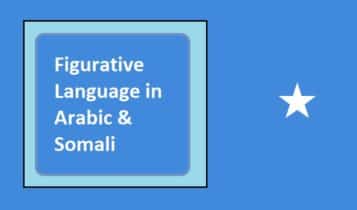Figurative Language in Arabic and Somali
Figurative Language in Arabic and Somali

Figurative Language in Arabic
In Arabic, figurative language is called اللغة المجازية (al-lughat al-majaziyya) or الكناية (al-kinaya), and it is deeply rooted in the language’s poetic and cultural heritage.
Examples
- Metaphor (استعارة – isti’ara):
- “قلب الأسد” (qalb al-asad) → “Heart of a lion” (meaning “brave”).
- “بحر من العلم” (bahr min al-‘ilm) → “A sea of knowledge” (describing someone very knowledgeable).
- Idioms (أمثال – amthal):
- “قطع الليل” (qata’a al-layl) → Literally “to cut the night,” meaning “to travel or work tirelessly.”
- “الوقت كالسيف” (al-waqt ka al-sayf) → “Time is like a sword” (if you don’t use it wisely, it cuts you).
- Proverbs (حكم – hikam):
- “الصديق وقت الضيق” (al-sadeeq waqt al-deeq) → “A friend in need is a friend indeed.”
Figurative Language in Somali
Somali is rich in figurative expressions, often tied to pastoral life, nature, and oral traditions. These are called habka suugaanta (figurative style) or maahmaah (proverbs).
Examples
- Metaphors:
- “Geedka ha u dhigin, hoostiisa ha fogaadin” → “Don’t abandon the tree’s roots” (stay connected to your origins).
- “Waa libaax qofka isku dayaya” → “He is a lion trying himself” (someone testing their courage).
- Idioms:
- “Indhahaaga ka daa” → Literally “Remove from your eyes,” meaning “Stop being naive.”
- “Nabad ma lagu gado?” → “Can peace be eaten?” (Peace is more valuable than material things).
- Proverbs (maahmaah):
- “Dhib ma dhaqaaqdo, waa la dhaqaaqaa” → “A problem doesn’t move on its own; you must act to solve it.”
- “Nin aan hilib lahayn, waa uun” → “A man without meat (wealth) is like a shadow” (powerless).
Key Differences
- Arabic: More formalized and tied to classical poetry (e.g., pre-Islamic qasidas) and Islamic texts like the Quran.
- Somali: Rooted in oral traditions, pastoral imagery, and communal wisdom.
Cultural Context
Both languages use figurative expressions to convey moral lessons, humor, and societal values. For example:
- Arabic often references deserts, camels, and historical events.
- Somali relies on livestock (goats, camels), nature, and clan dynamics.
Cultural Context
Both languages use figurative expressions to convey moral lessons, humor, and societal values. For example:
- Arabic often references deserts, camels, and historical events.
- Somali relies on livestock (goats, camels), nature, and clan dynamics.
